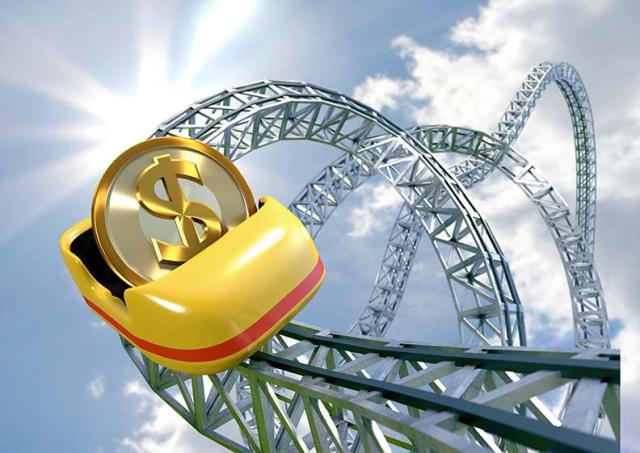
[Editor's note: A version of this story appears in the March 2019 edition of Oil and Gas Investor. Subscribe to the magazine here.]
Recent reports by Citi have warned of a period of commodity volatility, especially in crude markets. That has proven true, particularly in light of geopolitical events in Venezuela, Iran, Libya, China trade, etc. “Whatever OPEC’s response, volatility is here to stay,” said Citi.
Well, that’s only part of the story, as volatility in energy equities has recently more than matched that of the commodity. After a one-way ride down in the fourth quarter of last year, the roller coaster ride in energy equities staged a rebound early this year—only to be derailed again by concerns over U.S.-China trade talks in early February.
Market sentiment in the energy sector seems, moreover, to act like the tail end of the proverbial whip.
As a general rule, investors have emphasized the need for E&Ps to spend within cash flow and prioritize returns, and E&Ps have made tangible progress in meeting these goals. Even smaller mid-cap E&Ps, typically fighting steeper production declines, are easing back on growth to offer early returns.
What’s disheartening for investors is to see commodity swings being amplified into outsized moves in equity prices, even after E&Ps have moderated growth and improved capital efficiency.
An example is WPX Energy Inc. (NYSE: WPX), which cut its capital budget for 2019 by 23% at the mid-point in early February, while lowering prior production guidance by only 6%. With two less rigs, WPX projects it can still grow production by 5% to 10% from fourth-quarter 2018 to fourth-quarter 2019.
“We’ve worked hard over the past few years to position the company to spend within cash flow in a $50 world and still deliver nice growth,” said CEO Rick Muncrief.
The move by WPX “sends a strong positive feedback loop to investors and E&Ps,” said a Barclays report, noting WPX outperformed the XOP [S&P Oil & Gas Exploration & Production] ETF by 5% over the next couple of days. E&Ps’ search for “sustainable free cash flow with growth continues to be the Holy Grail in E&P,” commented Barclays in an earlier sector report.
As yet, however, strides by E&Ps toward such goals have often won only fleeting recognition in the market in absolute terms. More often, stock gains have been swept away in the next wave of volatility.
Although WPX’s stock gained ground initially, it was down 4.7% over the week of the revised budget release, ending Feb. 8, and was off 8.3% from its close on announcement. For the same week, the XOP was down 7.6%, while West Texas Intermediate was down 4.6% and Brent slipped 1%.
One of the earlier E&Ps to report, Anadarko Petroleum Corp. (NYSE: APC), saw its stock fall, much more so, as it released what several analysts described as “negative” or “disappointing” fourth-quarter results.
Cash flow per share came in below Street estimates by a mid- to high-teens percent, largely due to weaker than expected NGL prices and initial start-up issues with a gas processing plant. In addition, first-quarter output was guided 3% to 4% below Street expectations. However, earlier full-year 2019 capex and production guidance, based on $50-per-barrel oil, was kept unchanged.
Anadarko’s stock fell 7.4% on the day of the call, and it was then swept down a further 7.9% during the next two days. From reporting to week end, the stock was down about 14.7%.
A 14.7% retracement for a quarterly miss?
Other factors were certainly at work, but some analysts focused on funding needed by Anadarko as it is about to make a final investment decision on its Mozambique LNG project this year. Net of its share of project financing (ca. two-thirds of the project), Anadarko has indicated annual capex of $400- to $500 million, funded largely from cash flow and, as needed, sales of Western Gas stock.
Although long in the making, the Mozambique LNG project apparently raised questions as to how free cash flow would be affected. Last year, Anadarko bought back $3.75 billion of its shares, lowered debt by $600 million and paid an annualized dividend of around $600 million, making it among the top E&Ps in terms of investor returns.
According to a Bernstein report, investors can expect a 5% cash-flow yield in 2019 through 2020. Thereafter, there will be “a pause of two years as Mozambique capital peaks, [and] then decades of low decline cash flow from a project with roughly $6/boe finding and development costs.” A steady stream of free cash flow may be desirable, but “that’s difficult when mixed with large lumpy LNG projects.”
In today’s volatile markets, that typifies, in Bernstein’s words, “the battle of now vs. tomorrow.”
Chris Sheehan can be reached at csheehan@hartenergy.com.
Recommended Reading
Rhino Taps Halliburton for Namibia Well Work
2024-04-24 - Halliburton’s deepwater integrated multi-well construction contract for a block in the Orange Basin starts later this year.
Halliburton’s Low-key M&A Strategy Remains Unchanged
2024-04-23 - Halliburton CEO Jeff Miller says expected organic growth generates more shareholder value than following consolidation trends, such as chief rival SLB’s plans to buy ChampionX.
Deepwater Roundup 2024: Americas
2024-04-23 - The final part of Hart Energy E&P’s Deepwater Roundup focuses on projects coming online in the Americas from 2023 until the end of the decade.
Ohio Utica’s Ascent Resources Credit Rep Rises on Production, Cash Flow
2024-04-23 - Ascent Resources received a positive outlook from Fitch Ratings as the company has grown into Ohio’s No. 1 gas and No. 2 Utica oil producer, according to state data.
E&P Highlights: April 22, 2024
2024-04-22 - Here’s a roundup of the latest E&P headlines, including a standardization MoU and new contract awards.





